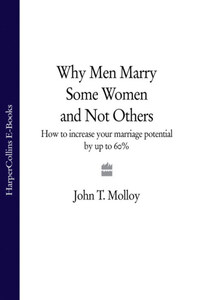Any single woman who lets the research in this book be her guide has not only a better chance of marrying, but also a better chance of marrying the man she truly desires. I personally oversaw the studies on which the text is based and used the same team that has been conducting dress, image, and sales research for Fortune 500 corporations and government agencies, both here and abroad, for more than forty years.
This book is not a set of rules on how to manipulate a man into marriage. Rather, it’s designed to provide women with valid statistical information that will help them make intelligent decisions in their search for that special man.
The first reason I believe this book will help women looking to switch their status from single to married is that its conclusions are based on thorough research. We interviewed, among others, 2,543 women and their fiancés coming out of marriage license bureaus, as well as 221 women in their late thirties and 463 in their forties who had no immediate prospects of marriage. We found that these two groups of women had different attitudes toward love, marriage, and life. We also discovered that unmarried women over forty had treated the men in their lives in a markedly different manner than the women who married in their twenties and early thirties. In addition, we sought information from some specific groups: men who went with one woman for years and immediately after breaking up with her married another; women who let others talk them out of marrying; men who had long-term relationships with one woman after another but never married; men who thought of themselves as confirmed bachelors; and so forth. Naturally, we ran focus groups anytime our interviews left questions unanswered or raised additional questions.
The second reason I believe this book will help women marry is that, during the last eleven years, between three hundred and four hundred single female researchers worked on the project or became familiar with the research, and more than half of them married within three years. Since 19 percent of these women were in their late thirties or early forties and many had virtually given up on the idea of marrying, this is an extraordinarily high number.
Finally, many of the very intelligent women who worked on the project believed the research helped them. I know, because scores of them thanked me personally and/or invited me to their weddings.
The study was born in the late 1980s when Robin, a researcher I had hired to help me with a survey for a San Francisco firm, called and told me she could not show up the next day. She was calling from her older sister’s place. As it happened, I knew Robin’s sister, Kelly; she had worked for me as a researcher a few years earlier. Apparently, Kelly had just found out that a man she had dated for almost three years and broken up with five months earlier was marrying another woman. Robin said Kelly was so upset she couldn’t leave her and even hinted that Kelly might be suicidal. Then she added, “It’s partially your fault.” Of course, I asked how it could be my fault.
Robin told me it wasn’t the first time this had happened to her sister. Kelly had gone out with another man for two years, and a year after he had broken up with her, he had married someone else. While Kelly was working for me as a researcher, Robin reminded me, I had said over and over: If an event repeats itself, there’s usually a reason for it. Then without another word, Robin hung up.
I was very upset that something I had said could make a person feel suicidal. No matter how innocuous the statement or how innocent my purpose had been, I felt pangs of guilt. Luckily, twenty minutes later the phone rang again. It was Kelly. Not only would Robin work the next morning, she said, but she herself would be willing to help. Then she added, “In return, I’d like you to do me a favor.” Kelly wanted me to spend the afternoon with her, she said, to help her develop a research project that would show her what she was doing wrong with men she dated. The two men had treated her in an identical way, and she was convinced I had been right—there was a reason. She didn’t want to turn off every man she met by making the same mistake she had made with those two.
I didn’t know if I could come up with a study that would uncover such personal information, but she said all she asked was that I do my best. When I continued to hesitate, Robin got on the phone and pleaded with me to help. Reluctantly, I agreed. I knew Kelly was a very good researcher, and I was confident that if I developed a survey, she had the skills to use it effectively.














